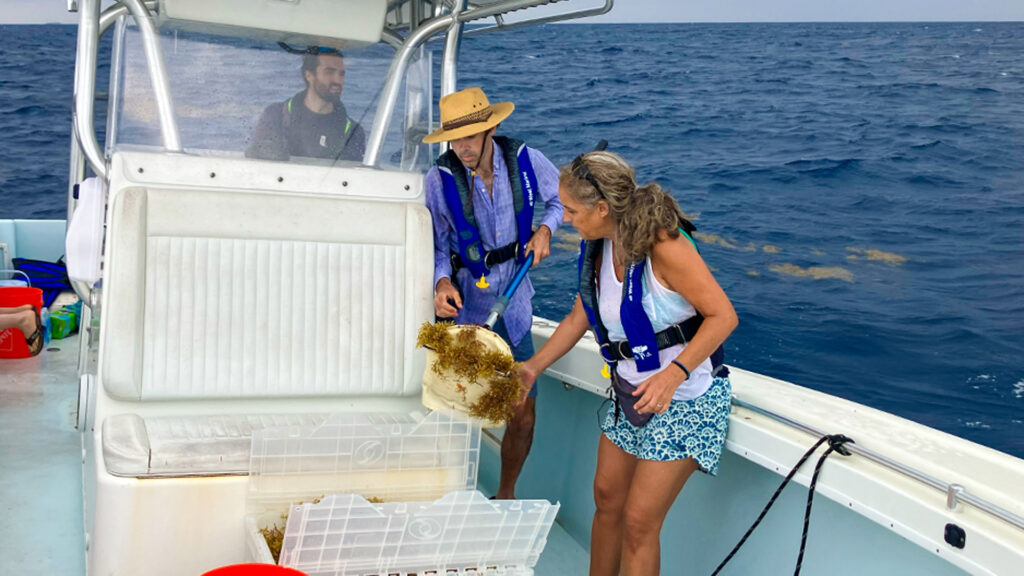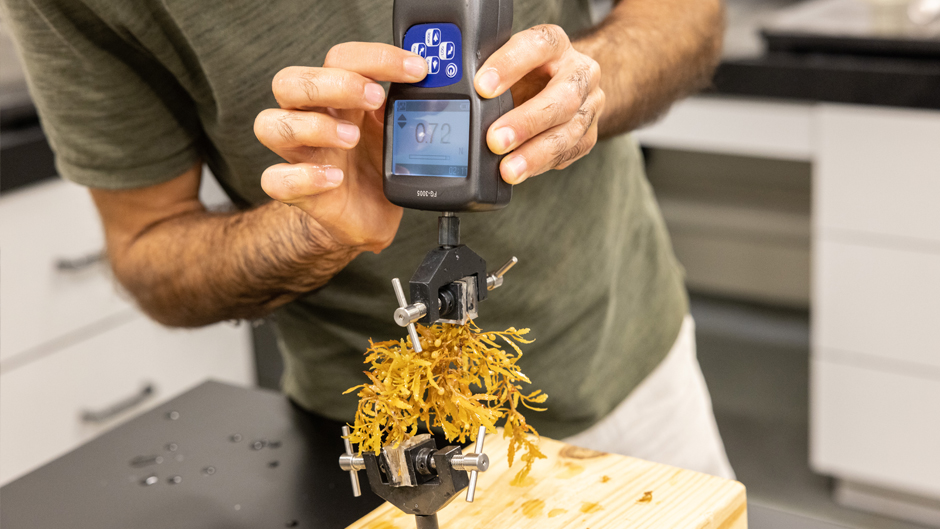By Robert C. Jones Jr., University of Miami
With the waves inside the 49-foot-long Air-Sea Interaction Saltwater Tank (ASIST) looking like small ripples rushing to a shoreline, University of Miami doctoral student Katie Simi stood on a small step ladder and dropped a clump of sargassum seaweed into the current.

Just a few steps away, Maria Josefina Olascoaga, a professor of ocean sciences, recorded all the action with a high-definition camcorder, jotting down the speed of the brown macroalgae after it traversed the length of the tank.
The whole process would be repeated more than a dozen times inside the Rosenstiel School of Marine, Atmospheric, and Earth Science’s SUSTAIN Laboratory.
While the experiment did not have the stunning visual effect of the simulated Category 5 hurricane conditions that are sometimes created in the tank’s bigger brother — the 75-foot-long Surge-Structure-Atmosphere Interaction wind-wave tank — it was of profound importance.
Using ASIST and other techniques, Olascoaga and team members from the Nonlinear Dynamics Laboratory are studying how the combined action of ocean currents, winds and waves affects the transport of sargassum seaweed.
Every year since 2011, the free-floating seaweed has inundated Caribbean, Gulf of Mexico and Florida coastlines during the hot summer months, emitting toxic fumes and wreaking havoc on coastal ecosystems as it decays.
“Understanding and learning more about its movement in order to predict where it will end up is challenging,” Olascoaga said. “Wave heights, current velocities, and wave energy all come into play. And that’s where ASIST is helping us.”
During three days of simulations, Olascoaga and her team placed several samples of sargassum into the ASIST tank, adjusting wave and wind velocities to determine the parameters for a mathematical model for the motion of sargassum rafts, flexible stems kept afloat by bladders filled with gas.
“The dynamical systems model envisions sargassum rafts as networks of floating particles of finite size connected by elastic springs,” said Francisco Javier Beron-Vera, a physical oceanographer and research associate professor in the Department of Atmospheric Sciences, who is coprincipal investigator with Olascoaga on her three-year National Science Foundation-funded study on the transport of sargassum seaweed.
The results of their experiments are being analyzed. But they are just one component of the project. Specially modified drifters deployed within thick matts of sargassum and an analysis of the biomechanical properties of the seaweed will complement what has been learned from data gleaned from the tank experiments.
Cedric Guigand, a senior research associate in the Department of Ocean Sciences, will lead a team of scientists up to 30 miles off the coast of Miami into the Gulf Stream to deploy 24 drifters equipped with GPS trackers into thick patches of sargassum, obtaining figures that will help validate the experiments conducted in ASIST.
Guigand has attached strings from mops to the bottom of each drifter to ensure they stay entangled in the sargassum. “They look like Medusas,” he said.
Now, it’s just a waiting game. Olascoaga and Beron-Vera are monitoring satellite ocean images, hoping to locate large matts of seaweed that can accommodate Guigand’s drifters.

Meanwhile, Nathan Putman and Taylor Beyea, scientists at LGL – Ecological Research Associates, which is participating in the study, are studying the tensile strength and stretching properties of sargassum seaweed, hoping to learn more about the forces that break it apart.
Gage Bonner, a postdoctoral associate and member of the Nonlinear Dynamics Laboratory, is working out statistical problems related to forecasting the arrival of sargassum at coastlines. “It’s something where we would be able to say, ‘Okay, there’s so much sargassum in this area. What times do we think it might start to arrive at various places?’ It’s a different aspect of the project that complements the other areas,” Gage said.
Gustavo Jorge Goni, a physical oceanographer with the National Oceanic and Atmospheric Administration’s Atlantic Oceanographic and Meteorological Laboratory, who is also collaborating on the project, said the study will help shed light on other areas of marine transport such as the accumulation of debris pollution and search-and-rescue operations at sea.
Olascoaga’s study comes after satellite images recently revealed massive patches of sargassum, known as the Great Atlantic Sargassum Belt, headed this way.
In some respects, the study is akin to storm forecasting, Olascoaga pointed out. “Of course, sargassum has its benefits. It’s a vital habitat that provides food and refuge for fish, birds, crabs, and many other marine organisms,” she said. “But still, we need to know how it is affected by ocean conditions to make any kind of predictions as to where it’s going. And that’s were our research comes in.”
This piece was originally published at https://news.miami.edu/stories/2023/06/travels-of-sargassum-seaweed-explored.html
Sign up for The Invading Sea newsletter by visiting here.



